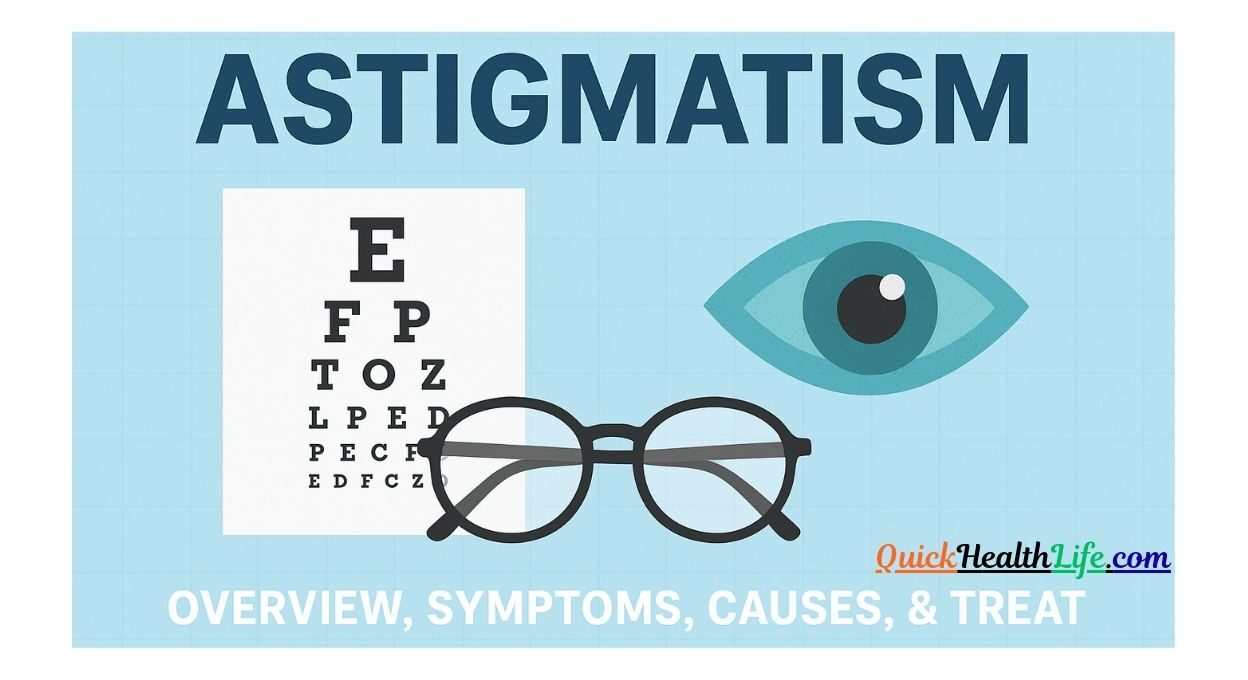Astigmatism causes blurred or distorted vision because the eye’s surface is shaped more like a football than a perfect sphere. The good news? It’s highly manageable once you understand it.
Table of Contents
Astigmatism Symptoms
Astigmatism can show up at any age. Common signs include:
- Blurred or distorted vision at all distances
- Eye strain and headaches, especially after reading or screen time
- Night vision problems, such as halos around lights
- Squinting or needing to move closer to objects to see clearly
If you notice these issues, schedule an astigmatism test with an eye doctor.
Causes of Astigmatism
Several factors can lead to astigmatism:
- Genetics – Many people are born with it.
- Eye injuries or surgery – Trauma can change the cornea’s shape.
- Keratoconus – A progressive thinning of the cornea.
It’s not caused by reading in dim light or sitting too close to the TV—those are myths.
Types of Astigmatism
Eye doctors classify astigmatism in different ways:
- Corneal vs. Lenticular – Whether the cornea or lens is misshapen.
- Regular vs. Irregular – Regular is evenly curved; irregular is uneven in multiple directions.
- With-the-Rule vs. Against-the-Rule – Refers to the steepest curve’s orientation.
Astigmatism Severity Scale
Eye specialists often describe severity as:
| Level | Cylinder Power (Diopters) | Description |
|---|---|---|
| Mild | <1.0 D | May not need correction |
| Moderate | 1.0–2.0 D | Glasses or contacts recommended |
| Severe | >2.0 D | Strong correction or surgery may help |
Get regular eye exams to track changes.
How Astigmatism Is Diagnosed
An eye exam is painless and quick. Your optometrist may use:
- Visual acuity test – Reading letters on a chart.
- Keratometry or corneal topography – Measures corneal curvature.
- Refraction – Determines your prescription.
Astigmatism Treatment
Treatment depends on your needs and lifestyle:
- Glasses – The simplest fix, with lenses that correct uneven focus.
- Contact lenses – Toric lenses are specially shaped for astigmatism.
- Refractive surgery – LASIK or PRK reshapes the cornea.
- Orthokeratology (Ortho-K) – Nighttime lenses that temporarily reshape the cornea.
What Causes Astigmatism to Worsen
Astigmatism can slowly increase with:
- Age-related changes in the cornea or lens
- Uncontrolled eye rubbing due to allergies
- Progressive eye conditions like keratoconus
Routine checkups help catch changes early.
Can Astigmatism Be Corrected?
Yes. Corrective lenses are highly effective.
Surgical options like LASIK can also provide long-term improvement. Your eye doctor will recommend the safest plan for your specific needs.
What to Avoid When You Have Astigmatism
To keep your eyes comfortable:
- Avoid poor lighting when reading or using screens.
- Limit excessive screen time and take regular breaks.
- Don’t skip yearly eye exams.
Can You Heal Astigmatism Naturally?
No scientific evidence proves that eye exercises or herbal remedies can “cure” astigmatism.
However, good nutrition, adequate sleep, and protecting your eyes from UV rays support overall eye health.
Complications if Left Untreated
Untreated astigmatism may lead to:
- Chronic eye strain and headaches
- Amblyopia (lazy eye) in children
- Difficulty with daily tasks like driving at night
Living Well with Astigmatism
You can lead a normal life by:
- Wearing your prescribed glasses or contacts consistently
- Taking regular screen breaks (20-20-20 rule)
- Scheduling yearly eye exams to track any changes
Frequently Asked Questions
1. What causes astigmatism?
Mostly genetics, but injuries or conditions like keratoconus can contribute.
2. Can astigmatism be corrected?
Yes—through glasses, contacts, or surgery such as LASIK.
3. What should I avoid with astigmatism?
Avoid eye rubbing, poor lighting, and skipping checkups.
4. Can you heal astigmatism naturally?
No, but a healthy lifestyle supports eye health.
5. How severe can astigmatism get?
It can range from mild (<1 D) to severe (>2 D). Regular exams keep it in check.
6. How often should I get an eye test?
At least once a year, or as advised by your eye doctor.
Conclusion
Astigmatism is common and manageable.As a health blogger with years of experience, I’ve seen how early testing and proper care—whether astigmatism glasses, contact lenses, or surgery—can protect vision and quality of life.Stay proactive, schedule regular eye exams, and follow your doctor’s advice to keep your eyesight clear.



